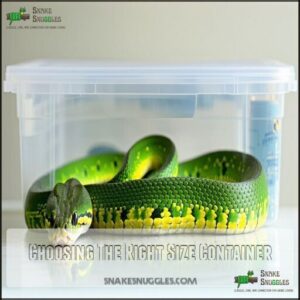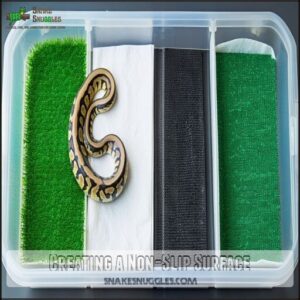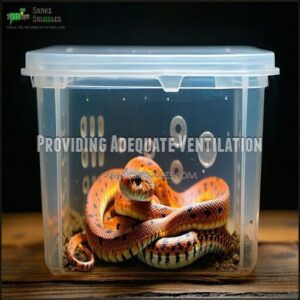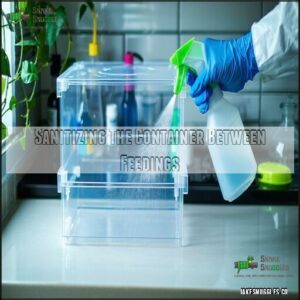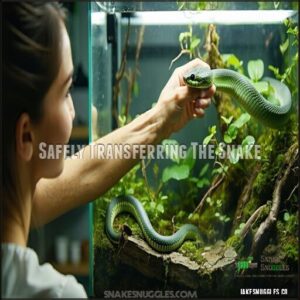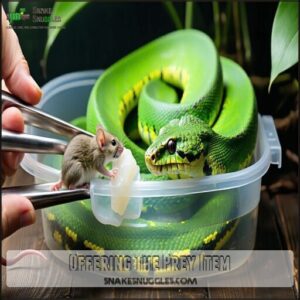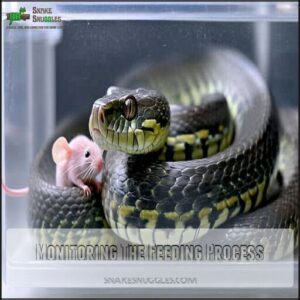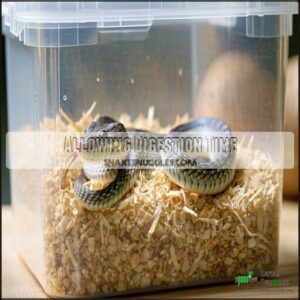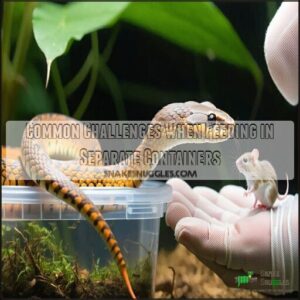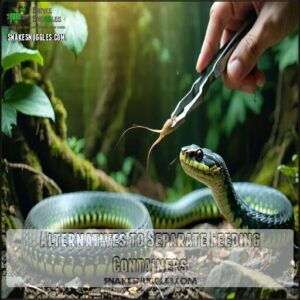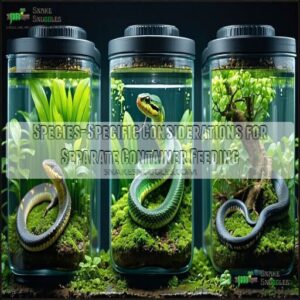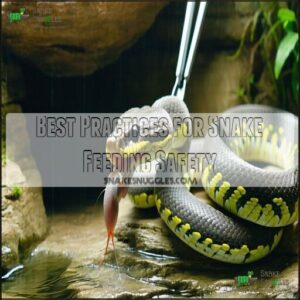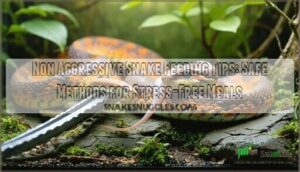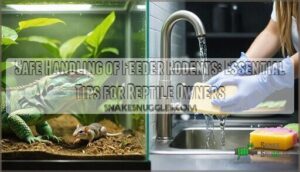This site is supported by our readers. We may earn a commission, at no cost to you, if you purchase through links.
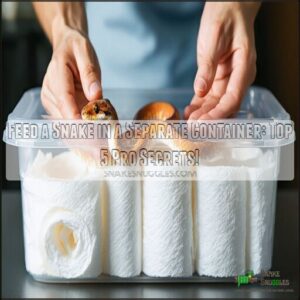
Grab a plastic tub with a secure lid, drill some air holes, and line the bottom with paper towels. Gently transfer your snake from its main habitat, ensuring minimal stress.
Place a pre-killed rodent inside and let your snake enjoy its meal undisturbed. This method reduces the risk of accidental substrate ingestion and makes monitoring easier.
By keeping feeding times calm and controlled, you’ll help your slithery friend stay healthy and happy. Wondering about tricky feeding situations? Stay tuned for expert tips.
Table Of Contents
- Key Takeaways
- Why Feed Snakes in Separate Containers?
- Pros and Cons of Separate Feeding Containers
- Preparing a Separate Feeding Container for Snakes
- Step-by-Step Guide to Feeding in Separate Containers
- Common Challenges When Feeding in Separate Containers
- Alternatives to Separate Feeding Containers
- Species-Specific Considerations for Separate Container Feeding
- Best Practices for Snake Feeding Safety
- Frequently Asked Questions (FAQs)
- What is the Best Type of Food to Feed My Snake?
- How Often Should I Feed My Snake?
- Are There Any Health Benefits to Feeding My Snake in a Separate Container?
- What Size Container Should I Use for Feeding My Snake?
- How Can I Tell if My Snake is Not Eating Enough?
- Should you feed a snake in a separate container?
- What not to do when feeding a snake?
- Should I feed my ball python in a different tank?
- How do you put a snake back in a cage after feeding?
- Are you supposed to feed snakes in a separate container?
- Conclusion
Key Takeaways
- You’ll minimize snake feeding risks by using a separate container, preventing substrate ingestion and reducing potential for accidental bites during mealtime.
- Your careful container preparation matters: choose a container that’s 1.5 times your snake’s length, ensure proper ventilation, maintain appropriate temperature and humidity, and create a non-slip surface.
- You’ll need to transfer your snake gently and strategically, using tools like snake hooks and feeding tongs to support its body and reduce stress during the feeding process.
- Different snake species have unique feeding preferences, so you’ll want to tailor your separate container approach to match your specific snake’s behavior, size, and temperament.
Why Feed Snakes in Separate Containers?
Are you looking to make snake feeding safer and smoother?
When you feed your snake in a separate container, you’ll minimize risks like accidental bites and substrate ingestion.
While creating a controlled, clean environment that keeps both you and your scaly friend happy.
Reduced Risk of Accidental Bites
When you’re working with snakes, minimizing bite risks isn’t just smart—it’s essential for handler safety.
Feeding snakes in a separate container creates a clear boundary between mealtime and handling, dramatically reducing accidental bite incidents.
- Your snake learns to distinguish between feeding and interaction zones
- You create a predictable, controlled environment that reduces striking responses
By strategically separating feeding spaces, you’re training your snake’s temperament and teaching it that your hands aren’t prey.
Feeding tongs become your trusted allies, allowing you to offer food without triggering defensive instincts.
This approach transforms potential fear into confident, safe snake care, making it a crucial part of safe snake handling.
Prevention of Substrate Ingestion
The nightmare of substrate ingestion haunts many snake owners.
When you feed your snake in a separate container, you eliminate the risk of bedding getting mixed with their prey.
Separate feeding containers: your snake’s clean, safe dining room—where prey meets precision, not potential peril.
A substrate-free environment guarantees your snake consumes only the intended meal, preventing dangerous impaction and costly veterinary interventions.
Tongs and careful prey placement become your best defense against this hidden health hazard.
Easier Monitoring of Feeding Behavior
Ever wondered what’s really happening during your snake’s mealtime? A separate feeding enclosure transforms you into a wildlife documentarian, giving you an unobstructed view of your pet’s dining drama.
By using a snake feeding container, you’ll discover three game-changing insights:
- Strike Speed Analysis: Watch how quickly and confidently your snake tracks its prey
- Consumption Time Tracking: Document exact feeding durations and prey item size preferences
- Shedding Cycle Impact: Observe how feeding behaviors shift during different life stages
This laser-focused observation isn’t just fascinating—it’s your secret weapon for detecting early signs of health issues like potential regurgitation. Think of it as your snake’s personal performance review, minus the awkward office small talk.
Cleaner Feeding Environment
Monitoring snake feeding just got a whole lot cleaner! Separate feeding containers transform your reptile care routine by creating a pristine, substrate-free environment that protects your snake’s health.
You’ll eliminate the messy nightmare of food debris contaminating the main enclosure, dramatically reducing bacteria and parasite risks. Think of it as a dedicated dining room for your scaly friend – a controlled space where hygiene reigns supreme.
Easy disinfection becomes your new superpower. By removing substrate from the feeding equation, you prevent accidental ingestion and keep your snake’s primary habitat spotless. No more worrying about decomposing prey or hidden waste.
With a simple plastic container, you’ll master waste management and create a safer, cleaner feeding experience that keeps both you and your snake happy and healthy.
Potential Stress Reduction for Some Snakes
A separate feeding container can be your snake’s ticket to a zen mealtime experience. By creating a dedicated space, you’ll help minimize handling stress and support more relaxed feeding behaviors.
Here’s how a thoughtful approach reduces snake anxiety:
- Eliminate habitat distractions that might trigger defensive responses
- Create a predictable, calm environment that signals "dinner time"
- Provide a gentle, secure transfer process that respects your snake’s comfort zone
Imagine transforming feeding from a potential nightmare into a smooth, controlled interaction. With careful handling and a minimal-disruption strategy, you’ll help your snake feel more secure during meals, potentially reducing regurgitation risks and supporting overall snake stress reduction.
Pros and Cons of Separate Feeding Containers
Master snake feeding with strategic container techniques that balance impaction prevention and stress reduction. Your approach can make or break a successful meal!
The key is understanding your snake’s unique temperament. While a separate container offers multiple benefits like container sanitation and aggression mitigation, it’s not a one-size-fits-all solution.
| Pros | Cons |
|---|---|
| Substrate ingestion prevention | Potential feeding stress |
| Reduced enclosure aggression | Regurgitation risk |
| Easier feeding monitoring | Handling difficulties |
| Cleaner feeding environment | Time-consuming process |
Some snakes thrive with minimal disruption, while others adapt quickly to new feeding spaces. Always offer pre-killed prey to avoid potential injuries.
Preparing a Separate Feeding Container for Snakes
You’re about to become a snake feeding pro by mastering the art of separate container preparation.
By following these essential steps, you’ll create a safe and stress-free dining experience that keeps both you and your slithery friend happy and healthy.
Choosing The Right Size Container
Sizing up your snake’s feeding container is like tailoring a perfectly comfortable dining room. Choose a separate container roughly 1.5 times your snake’s relaxed length, guaranteeing ample maneuverability.
Measure your serpent when stretched out calmly to get precise dimensions. The ideal snake feeding container should provide enough space for natural movement, with a width at least double the snake’s body diameter.
This approach guarantees comfort and prevents stress during mealtime. Consider appropriate container options to guarantee a safe environment.
Prioritize container dimensions that allow your snake to turn around easily, creating a safe, spacious feeding environment that mimics their natural habitat.
Ensuring Proper Temperature and Humidity
After selecting the right container, you’ll want to transform it into a climate haven for your slithery friend. Think of it as creating a tropical getaway that mirrors your snake’s native environment.
- Track temperature zones with a digital thermometer (85-90°F basking, 80-85°F warm side)
- Use a hygrometer to dial in precise humidity levels
- Aim for species-specific climate control
Your goal is to craft a feeding space that feels like home. A quick wrist test can confirm you’re in the right temperature range – if it feels comfortably warm without being hot, you’re on track.
Many reptile owners use a snake’s digital thermometer to monitor the enclosure, ensuring they provide the best environment for their pet, which is a key part of creating a tropical getaway and maintaining the right temperature range.
Creating a Non-Slip Surface
Since your snake’s safety hinges on a stable feeding environment, you’ll want to create a rock-solid non-slip surface that prevents mealtime mishaps.
Check out these grip enhancement strategies that’ll keep your slithery friend secure:
| Surface | Slip Resistance | Durability | Cleaning | Best For |
|---|---|---|---|---|
| Reptile Carpet | High | Long-lasting | Moderate | Regular use |
| Paper Towels | Medium | Disposable | Easy | Quick setup |
| Rubber Matting | Maximum | Excellent | Simple | Heavy snakes |
| Shelf Liner | High | Good | Easy | All species |
| Indoor/Outdoor Carpet | High | Excellent | Moderate | Large snakes |
Textured materials are your secret weapon against substrate ingestion and sliding. Consider that proper substrate selection is essential for snake health.
DIY solutions like shelf liners can transform your separate container into a snake-safe dining zone.
Providing Adequate Ventilation
Regularly, crafting the perfect snake feeding environment hinges on smart ventilation strategies. Your separate container isn’t just a meal zone—it’s a lifeline for your reptilian friend’s comfort and health.
- Create strategic ventilation holes matching your snake’s enclosure size
- Install mesh screens to block escape routes
- Guarantee cross-flow airflow for ideal oxygen exchange
- Position holes to maintain consistent temperature
- Balance humidity levels to prevent mold growth
Think of ventilation like your snake’s personal breathing system. Proper airflow reduces stress, prevents respiratory issues, and keeps your slithery companion calm during feeding time. A well-designed ventilation setup transforms a simple container into a safe, breathable dining space that supports your snake’s natural rhythms, ensuring a healthy environment for your pet, which is crucial for its overall well-being and comfort.
Sanitizing The Container Between Feedings
Keeping your snake’s feeding container pristine isn’t just a chore—it’s a critical health strategy. After each feeding, you’ll want to disinfect with reptile-safe cleaning solutions that banish bacteria without harming your scaly friend.
Opt for specialized sanitizers like chlorhexidine or F10, diluted to match manufacturer instructions. Different container types demand specific disinfection methods: plastic bins might need vinegar, while glass tanks require weekly deep cleaning with reptile-approved solutions.
Steer clear of harsh household cleaners that could introduce toxic residues. Remember, preventing cross-contamination means thorough cleaning between feedings, ensuring your separate container remains a safe, hygienic dining spot for your snake.
Step-by-Step Guide to Feeding in Separate Containers
If you’re looking to master snake feeding like a pro, using a separate container can be a game-changer for both you and your scaly friend.
You’ll minimize stress, prevent substrate ingestion, and create a safer feeding environment that keeps both handler and snake happy and healthy, which is a key aspect of mastering snake feeding.
Safely Transferring The Snake
Your carefully prepared feeding container awaits your slithery friend’s arrival. With snake handling techniques that whisper confidence, you’ll master the art of stress-free transfer.
- Use snake hooks to guide your serpent gently
- Support the snake’s body like a delicate treasure
- Move with deliberate, smooth motions
- Watch for subtle stress signals
Think of transferring your snake as a careful dance – one where you’re the patient lead. Your hands should be firm yet soft, creating a secure pathway from enclosure to feeding container.
Avoid sudden movements that might trigger defensive reactions. By maintaining a calm demeanor and using controlled handling techniques, you’ll minimize potential injury risks and keep your snake feeling secure during the transfer process. With deliberate and smooth motions, you ensure a safe transfer.
Offering The Prey Item
Your snake’s about to feast, and your feeding tongs are your secret weapon.
When offering prey in a separate container, match the prey size precisely to your snake’s body width. Frozen/thawed items should be warmed to body temperature—around 98-100°F—to trigger that hunting instinct.
Gently dangle or wiggle the prey to mimic natural movement, making even picky eaters perk up. Pro tip: for stubborn snakes, try scenting the prey with a drop of chicken broth or fish oil.
Always use tongs to prevent hand-biting accidents, and choose prey that’s pre-killed to guarantee safety. Remember to thaw frozen prey properly before feeding.
Your snake’s dinner is all about presentation and technique.
Monitoring The Feeding Process
After gently placing the prey in your separate container, your hawk-eye observation becomes your secret weapon.
Watch like a pro for these telltale signs of successful prey consumption:
- Smooth, confident strike accuracy
- Natural coiling behavior around food
- Consistent swallowing motion
- Minimal stress indicators
Your mission is to stay perfectly still and quiet, blending into the background like a feeding-time ninja.
By tracking these subtle behavior changes, you’ll catch any potential issues early and guarantee your scaly friend enjoys a stress-free meal in their dedicated feeding space, ensuring a successful and quiet experience.
Allowing Digestion Time
After your snake devours its meal, respect the digestion marathon ahead. Those 1-2 hours are gold for metabolic processing—think of it as their personal power nap.
Just like humans need downtime after a feast, your reptilian friend requires uninterrupted rest. Keep the environment calm and quiet, minimizing potential regurgitation risks.
| Time | Temperature | Behavior |
|---|---|---|
| 0-30 min | Stable | Minimal movement |
| 30-60 min | Warm | Slight shifting |
| 60-90 min | Consistent | Relaxed |
| 90-120 min | Steady | Inactive |
The table outlines the expected behavior and environmental conditions for your snake during the digestion period, emphasizing the need for a stable and quiet environment to support their relaxed state.
Returning The Snake to Its Enclosure
Reintroducing your snake back home requires finesse and precision after feeding.
Here’s your roadmap for a smooth, stress-free reintroduction:
- Verify habitat conditions match ideal temperature and humidity
- Open enclosure door fully to prevent unintended contact
- Support entire body during safe transfer, treating them like precious cargo
- Lower snake gently, minimizing potential disruption
- Secure latches and observe their settling for 10 quiet minutes
Your goal? A seamless return that keeps your slithery friend calm and comfortable in their sanctuary.
Common Challenges When Feeding in Separate Containers
When feeding your snake in a separate container, you’ll inevitably encounter some tricky challenges that can test your patience and snake-handling skills.
From managing your snake’s stress to preventing regurgitation during transfer, these obstacles require careful navigation and a strategic approach to guarantee a smooth, successful feeding experience.
Reluctance to Eat in New Environment
Uprooting your snake from its comfort zone can turn mealtime into a challenging puzzle of prey acceptance. When introducing a separate feeding container, you’ll likely encounter some initial resistance that tests your patience.
Here’s what to expect:
- Environmental stressors can trigger temporary feeding refusal
- Snakes need time to recognize the new space as safe
- Gradual introduction helps minimize handling-related stress
Your feeding routine requires a delicate touch. Cover the container with a towel to reduce visual stimuli and create a sense of security. Don’t rush the process—some snakes may take days or weeks to adjust to alternative feeding methods.
Remain calm, consistent, and observant throughout the adjustment.
Increased Stress in Some Snakes
The serpent’s delicate temperament can turn a routine feeding into a stress-fueled standoff when relocated.
Handling stress becomes critical to prevent feeding refusal and regurgitation risks.
| Stress Indicator | Environmental Trigger | Mitigation Strategy |
|---|---|---|
| Defensive Coiling | Sudden Movement | Slow, Predictable Approach |
| Hissing | Unfamiliar Space | Consistent Handling Routine |
| Body Vibration | Temperature Fluctuation | Maintain Stable Environment |
| Striking Posture | Rapid Handler Movements | Calm, Deliberate Actions |
Risk of Regurgitation During Transfer
Moving your snake after a meal can be a recipe for digestive disaster. Stress disrupts their delicate digestion, triggering potential regurgitation.
To keep your snake’s dinner down:
- Wait at least 1 hour post-feeding
- Support their entire body during transfer
- Minimize handling after meals
- Maintain a calm, quiet environment
Handling stress can make or break successful snake feeding. Your gentle touch and patience prevent snake regurgitation, ensuring ideal digestion in a secure enclosure.
Difficulty With Large or Aggressive Snakes
When large, aggressive snakes enter the feeding scene, your strategy needs serious precision.
Handling these serpentine powerhouses requires nerves of steel and smart techniques:
- Use a snake hook to maintain distance and control during transfers
- Select prey sized perfectly to prevent aggressive striking
- Gradually introduce separate feeding containers near their primary habitat
Pro snake handlers know bite prevention isn’t about bravado—it’s about calculated moves.
Specialized equipment like long feeding tongs becomes your best friend, creating a safe buffer between you and potential aggression.
By understanding each snake’s unique temperament, you’ll transform potentially dangerous feeding sessions into smooth, controlled experiences.
Time-Consuming Process for Multiple Snakes
Anyone managing multiple snakes knows the feeding process can quickly become overwhelming.
Batch feeding becomes your secret weapon for efficient snake care. By strategically grouping snakes by species and size, you’ll streamline your feeding routine using prioritization strategies that minimize handling stress.
Automated feeders and a well-planned feeding schedule can transform a time-consuming chore into a smooth, systematic process.
Smart time management means less stress for you and your scaly companions, allowing for a more efficient and smooth process.
Alternatives to Separate Feeding Containers
If you’re not keen on using separate feeding containers, you’ve got some smart alternatives that can make snake feeding easier and less stressful.
From feeding in their main enclosure to using tap training techniques, you’ll discover practical methods that can simplify your snake care routine.
You’ll keep your slithery friend happy.
Feeding in The Main Enclosure
When wrestling with the challenges of snake feeding, your main enclosure might just be your secret weapon.
Feeding in familiar territory keeps stress levels low and mimics natural behavior. But tread carefully: substrate ingestion lurks around every corner!
Your pro moves include:
- Use feeding tongs to prevent accidental bites
- Keep substrate clean to reduce impaction risk
- Offer pre-killed prey for safety
- Monitor snake’s feeding response closely
- Maintain pristine enclosure conditions
By mastering these techniques, you’ll transform feeding from a potential headache into a smooth, predictable routine that keeps both you and your scaly friend happy.
Using a Designated Feeding Area
Create a smart designated feeding area within your snake’s enclosure that transforms mealtime from stressful to seamless.
This strategic space minimizes substrate ingestion risks while supporting behavioral conditioning and reducing overall snake stress.
Opt for a clean, flat surface away from hiding spots, preferably on a smooth, easily washable section of the habitat.
Use feeding tongs to place prey precisely, ensuring a hygienic feeding environment that feels natural and controlled.
Your snake will appreciate the consistency, and you’ll master the art of stress-free feeding without the hassle of a separate container.
Remember: location is everything in snake dining!
Implementing Tap Training Techniques
Master the art of tap training with five simple techniques that transform your snake’s feeding routine.
By establishing a consistent tap rhythm, you’ll create a reliable feeding cue that reduces bite risks and builds trust.
Target training helps desensitize your snake, making meal times smoother. Species-specific tapping methods work wonders—some snakes learn faster than others.
Practice patience, and you’ll develop a unique communication method that makes separate container feeding a breeze.
Utilizing Feeding Tongs or Forceps
In snake feeding, tongs and forceps are your secret weapons for safe, precise prey handling.
These tools transform your feeding routine from risky to razor-sharp professional.
- Minimize bite risks with strategic prey presentation
- Control meal placement with pinpoint accuracy
- Sanitize feeding tongs to prevent cross-contamination
- Match forceps size to your snake’s feeding needs
- Protect yourself with injury prevention techniques
Choosing the right feeding tongs involves considering grip strength and material durability.
Stainless steel options offer the best combination of strength and hygiene for snake handling.
Consider various tong options for different sized prey.
When presenting prey, use gentle, controlled movements that mimic natural prey behavior.
Pro tip: Practice your technique before feeding to build confidence and smooth out your approach.
Remember, confident handling leads to stress-free snake feeding experiences that keep both you and your serpent friend safe.
Species-Specific Considerations for Separate Container Feeding
Not all snakes have the same feeding needs, so you’ll want to tailor your separate container feeding approach to your specific snake species.
By understanding each snake’s unique preferences and behavior, you’ll create a less stressful and more successful feeding experience that keeps your scaly friend healthy and happy.
Ball Python Feeding Preferences
When evening falls, your ball python craves a perfect feeding ritual in a separate container.
Your snake’s success hinges on precise prey selection and environmental control.
3 pro tips for feeding like a snake whisperer:
- Match prey to 1-1.5 times mid-body width
- Warm prey to body temperature (98-100°F)
- Maintain 60-80% humidity during nocturnal feeding
Corn Snake Feeding Behavior
If you’re switching from ball pythons’ finicky appetites, corn snakes will feel like a welcome change. These natural hunters have predictable feeding behaviors that make separate container feeding a breeze.
Your corn snake’s prey should match its head width – about 1-1.5 times larger for perfect digestion.
- Adult corn snakes thrive on a 7-10 day feeding schedule, with growing juveniles needing more frequent meals.
Watch for telltale hunting signs: dilated eyes, rapid tongue flicks, and that unmistakable pre-dinner excitement. During shedding, skip meals to prevent potential regurgitation.
By understanding their feeding behavior, you’ll transform snake feeding from a chore into a fascinating ritual of natural instincts.
King Snake Feeding Aggression
King snakes aren’t just another reptile – they’re feeding machines with lightning-fast strikes and zero patience.
Their food aggression demands a strategic approach using separate containers and smart handling techniques.
Here’s a snapshot of their feeding persona:
| Trait | Behavior | Management |
|---|---|---|
| Strike Speed | Ultra-Fast | Tongs Required |
| Hunger Level | Intense | Controlled Feeding |
| Bite Risk | High | Separate Container |
| Temperament | Aggressive | Tap Training |
Tap training and careful container selection will transform your king snake feeding experience from nerve-wracking to smooth sailing with controlled feeding and tap training.
Boa Constrictor Size and Feeding Needs
After wrangling feisty king snakes, let’s tackle the heavyweight champion of snake feeding: your boa constrictor. Here’s how to nail their nutrition in a separate container:
- Sizing Up Success: Your feeding container’s the stage – 75-100 gallons gives your boa room to strike and coil.
- Meal Blueprint: Match prey to 10-15% of body weight. Young boas feast every 5-7 days; adults, every 10-14 days.
- Growth Gameplan: These serpents can stretch 6-13 feet, so adjust portions as they bulk up.
- Digestion Downtime: Give 2-3 days between meals, letting winter slow the feeding rhythm.
To guarantee healthy growth, remember prey size matters.
Arboreal Snake Feeding Challenges
If you’re branching out into arboreal snake care, your feeding strategy needs to climb to new heights.
Unlike ground-dwelling species, tree snakes demand a vertical feeding environment that mirrors their natural behaviors.
Your separate container should become a mini-canopy with sturdy branches strategically placed at different elevations.
When presenting prey, use tongs to mimic aerial hunting – think predator striking from above.
Secure branch placement prevents awkward meal-time tumbles, while maintaining high humidity guarantees your climbing companion feels right at home.
By customizing your feeding setup, you’ll transform mealtime from a simple feed into an artful dance that respects your snake’s innate arboreal instincts, where precision is key in this sky-high dining experience.
Best Practices for Snake Feeding Safety
Feeding your snake safely requires more than just tossing prey into its enclosure – it’s about creating a controlled, stress-free environment.
When you follow key safety practices, you’ll protect both yourself and your scaly friend from potential feeding-related mishaps.
Proper Handling Techniques During Feeding
Mastering snake feeding requires finesse and strategy. Your handling techniques can make or break the meal experience.
Here’s your roadmap to safe snake dining:
- Hook and Guide: Use a snake hook to gently direct the snake’s movement, supporting its body with calm, confident motions.
- Tongs as Your Shield: Always leverage feeding tongs to maintain a safe distance, preventing accidental bites during prey transfer.
- Stress-Free Transfer: Move your snake smoothly between containers, minimizing sudden movements that could trigger defensive reactions.
Your goal? A peaceful feeding ritual that keeps both you and your slithery friend safe. Remember, confidence is key – your snake can sense hesitation. Smooth, deliberate actions communicate control and reduce the likelihood of aggressive responses during feeding in a separate container.
Recognizing Signs of Feeding Aggression
When handling snakes during feeding, you’ll want to read their pre-strike cues like a pro.
Watch for telltale signs of snake feeding aggression: a tense, coiled body; rapid tongue flicks; a raised, S-shaped neck signaling potential attack.
Different snake species have unique aggression triggers, so understanding individual snake temperament is key.
Pay attention to post-feed behavior and handling challenges.
Your safety depends on recognizing these warning signs early, and a snake’s body language speaks volumes – learn to listen, and you’ll navigate feeding time with confidence and control.
Avoiding Hand-Feeding Mistakes
After spotting aggression cues, your hand-feeding skills become your snake’s safety net.
With snake feeding mistakes lurking, you’ll want to nail these pro tips:
- Use tongs technique: Never hand-feed directly, minimizing snake bite risks.
- Perfect prey presentation: Hold prey calmly, mimicking natural movement.
- Read snake signals: Watch for hesitation or defensive postures.
In your separate container, approach feeding like a strategic dance.
Gentle movements, confident grip, and zero sudden jerks transform potential danger into a smooth, stress-free meal.
Your goal? Create a safe feeding environment that keeps both you and your slithery friend comfortable and secure.
Maintaining a Consistent Feeding Schedule
After avoiding hand-feeding mishaps, nail your snake’s feeding schedule like a pro.
Create a consistent feeding routine that matches your snake’s size, age, and metabolism. Mark your calendar for regular feeding days, tracking prey size and weight to keep your slithery friend in top shape.
Adjust your approach seasonally, ensuring your snake gets the right nutrition without missing a beat.
Remember, a well-planned feeding schedule is your secret weapon.
Frequently Asked Questions (FAQs)
What is the Best Type of Food to Feed My Snake?
Choose frozen-thawed rodents that match your snake’s size, ensuring they’re no wider than its mid-body.
Always handle prey with tongs, warm slightly to body temperature, and offer at regular intervals based on your snake’s species, using tongs.
How Often Should I Feed My Snake?
You’ll want to feed most snakes every 7-14 days, depending on their age, species, and size.
Younger snakes typically need more frequent meals, while adults can go longer between feedings.
Always monitor your snake’s body condition and consult a vet to ensure the best care, as this will help determine the right feeding schedule.
Are There Any Health Benefits to Feeding My Snake in a Separate Container?
Picture your snake as a fastidious diner in a pristine restaurant.
Feeding in a separate container prevents substrate ingestion, reduces enclosure aggression, and helps you monitor your snake’s health more effectively during mealtime, which improves overall health.
What Size Container Should I Use for Feeding My Snake?
Your snake’s feeding container should match its length.
Aim for a tub slightly larger than your snake, with smooth sides and secure lid.
Make certain it’s tall enough to prevent escape but not so spacious that it causes stress.
How Can I Tell if My Snake is Not Eating Enough?
Yo, dial back the anxiety!
Watch for signs like weight loss, lethargy, and skipped meals.
Check your snake’s body condition, track feeding frequency, and consult a vet if concerns persist about its nutritional intake.
Should you feed a snake in a separate container?
You’ll reduce substrate ingestion risks and prevent feeding aggression by using a separate container.
It’ll help your snake associate food with a specific space, making feeding time smoother and safer for both of you.
What not to do when feeding a snake?
Don’t handle your snake immediately after feeding, use live prey, or ignore proper prey size.
Always use tongs, avoid distractions, and never force-feed.
Maintain calm during the process and wash your hands thoroughly afterward, to ensure a safe and healthy environment for your snake, and always prioritize calm handling.
Should I feed my ball python in a different tank?
You’ll want to feed your ball python in a separate tank to prevent substrate ingestion, reduce feeding aggression, and create a safer mealtime environment.
It’ll help keep both you and your snake stress-free during feedings.
How do you put a snake back in a cage after feeding?
Like a seasoned tamer, gently place your snake back in its enclosure post-feeding.
Wait an hour, use a soft touch, and move slowly to minimize stress.
Keep the handover calm and smooth.
Are you supposed to feed snakes in a separate container?
It depends on your snake’s temperament.
Separate container feeding can prevent substrate ingestion and aggression, but it might stress your snake.
Choose the method that keeps your pet calm and comfortable during mealtime.
Conclusion
Whether you’re a rookie or a seasoned snake keeper, learning to feed a snake in a separate container is an art and science.
Master the technique, and you’ll transform feeding time from stressful to seamless.
By prioritizing safety, minimizing risks, and creating a controlled environment, you’ll guarantee your scaly companion enjoys stress-free meals.
Remember, patience and practice make perfect – your snake will thank you with healthy eating habits and reduced potential for feeding complications.



